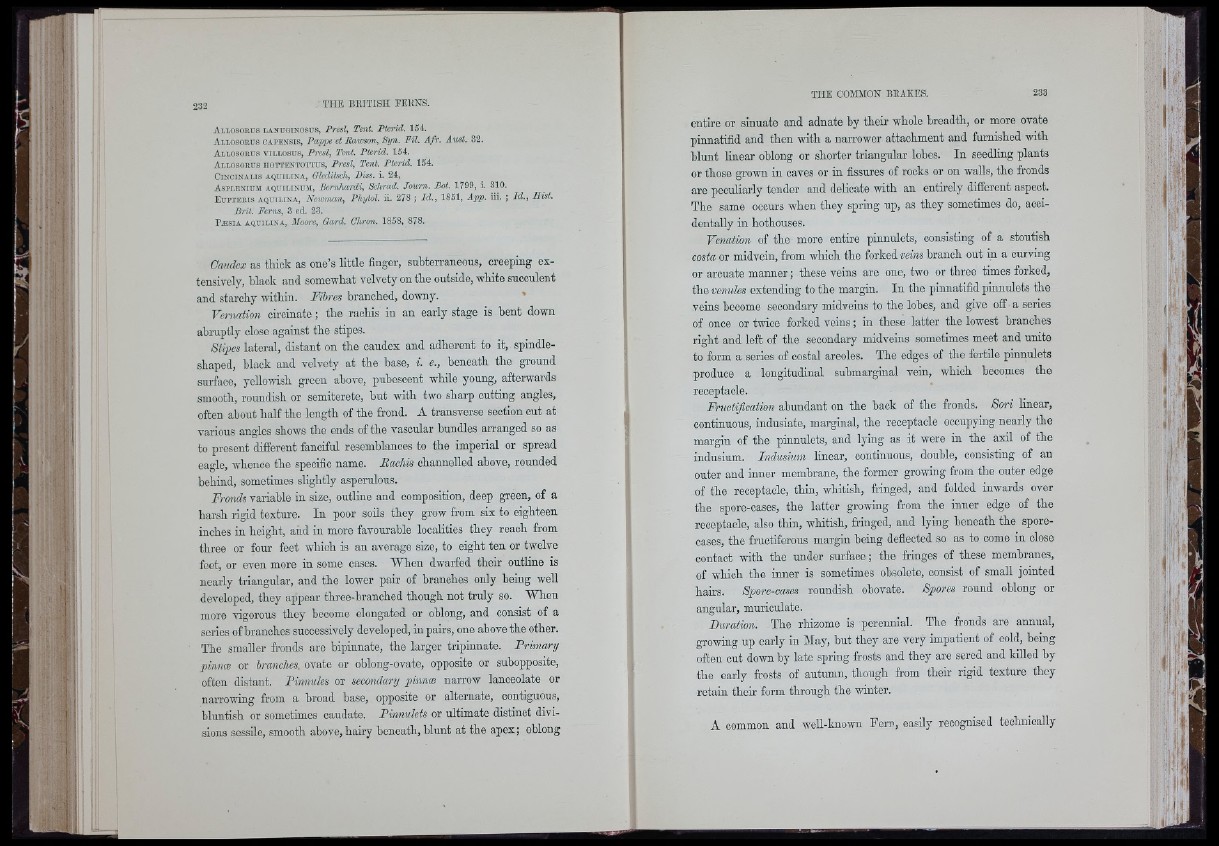
A llosorus lanuginosus, Presl, Tent. Pterid. 1 5 4 .
A l lo so r u s c a p e n s is , Pappe et Rawson, Syn. Fil. A fr. Aust. 32 .
A l lo so r u s v il l o s u s . Presi, Tent. Pterid. 15 4 .
A l l o so r u s h o t t e n t o t t u s , Presi, Tent. Pterid. 1 5 4 .
C in c in a l is a q u i l in a , Glcditsch, Diss. i. 2 4 ,
A s p l e n iu m a q u il in u m , Bernhardi, Schrad. Journ. Bot. 1 7 9 9 , i. 3 1 0 .
E u p t e r i s a q u i l i n a , Ncioman, Phytol. i i . 2 7 8 ; Id ., 1 8 5 1 , App. i i i . ; Id ., Hist.
Brit. Fcriis, 3 e d . 23.
PiESiA AQUILINA, Moorc, Gard. Chron. 1 8 5 8 , 8 7 8 .
Cmdex as thick as one’s little finger, subterraneous, creeping extensively,
black and somewhat velvety on the outside, white succulent
and starchy within. Fibres branched, downy. ’
Vernation circinate ; the rachis in an early stage is bent down
abruptly close against the stipes.
Stipes lateral, distant on the caudex and adherent to it, spindle-
shaped, black and velvety at the base, i. e., beneath the ground
surface, yellowish green above, pubescent while young, afterwards
smooth, roundish or semiterete, but with two sharp cutting angles,
often about half the length of the frond. A transverse section out at
various angles shows the ends of the vascular bundles arranged so as
to present different fanciful resemblances to the imperial or spread
eagle, whence the specific name. Rachis channelled above, rounded
behind, sometimes slightly asperulous.
Fronds variable in size, outline and composition, deep green, of a
harsh rigid texture. In poor soils they grow from six to eighteen
inches in height, and in more favourable localities they reach from
three or four feet which is an average size, to eight ten or twelve
feet, or even more in some cases. When dwarfed their outline is
nearly triangular, and the lower pair of branches only being well
developed, they appear three-branched though not truly so. When
more vigorous they become elongated or oblong, and consist of a
series of branches successively developed, in pairs, one above the other.
The smaUer fronds are bipinnate, the larger tripinnate. Primary
pinnce or branches, ovate or oblong-ovate, opposite or subopposite,
often distant. Finnules or secondary pinnæ narrow lanceolate or
narrowing from a broad base, opposite or alternate, contiguous,
bluntish or sometimes caudate. Rinnulets or ultimate distmot divisions
sessile, smooth above, hairy beneath, blunt at the apex ; oblong
entire or sinuate and adnate by their whole breadth, or more ovate
pinnatifid and then with a narrower attachment and furnished with
blunt Unear oblong or shorter triangular lohes. In seedling plants
or those grown in caves or in fissures of rocks or on walls, the fronds
are peculiarly tender and delicate with an entirely different aspect.
The same occurs when they spring up, as they sometimes do, acoidentaUy
iu hothouses.
Venation of tho more entire pinnulets, consisting of a stoutish
costa or midvein, from which the forked veins branch out in a curving
or arcuate manner ; those veins are one, two or three times forked,
the venules extending to the margin. In the pinnatifid pinnulets the
voins become secondary midveins to the lobes, and give off a series
of once or twice forked veins ; in these latter the lowest branches
right and loft of the secondary midveins sometimes meet and unite
to form a series of costal areoles. The edges of the fertile pinnulets
produce a longitudinal suhmarginal vein, which becomes the
receptacle.
Fructification abundant on the hack of the fronds. Sori linear,
continuous, indusiate, marginal, tho receptacle occupying nearly the
margin of the pinnulets, and lying as it were in the axil of the
indusium. Indusium Unear, continuous, double, consisting of an
outer and inner membrane, tho former growing from the outer edge
of the receptacle, thin, whitish, fringed, and folded inwards over
the spore-cases, the latter growing from the inner edge of the
receptacle, also thin, whitish, fringed, and lying beneath the spore-
cases, the fructiferous margin being deflected so as to come in close
contact with the uuder surface; the fringes of these membranes,
of which the inner is sometimes obsolete, consist of small jointed
hairs. Spore-cases roundish obovate. Spores round oblong or
angular, muriculate.
Buration. The rhizome is perennial. The fronds are annual,
growmg up early in May, but they are very impatient of cold, heing
often out down by late spring frosts and they are sered and kiUed by
the early frosts of autumn, though from their rigid texture they
retaiu their form through the winter.
A common and woU-kiiown Fern, easily recognised technically
tifi
i ■’ 11
: À
ti'>{
■( H
;i i
m
■ih !
f i l
I
m